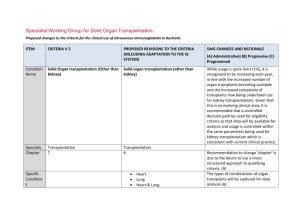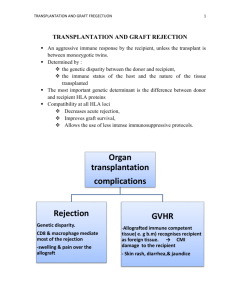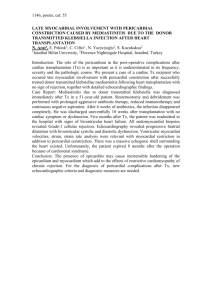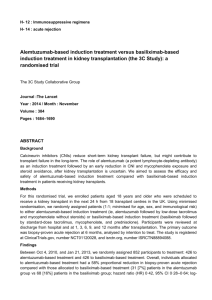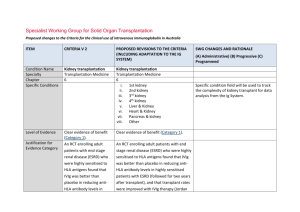Kidney transplantation
advertisement
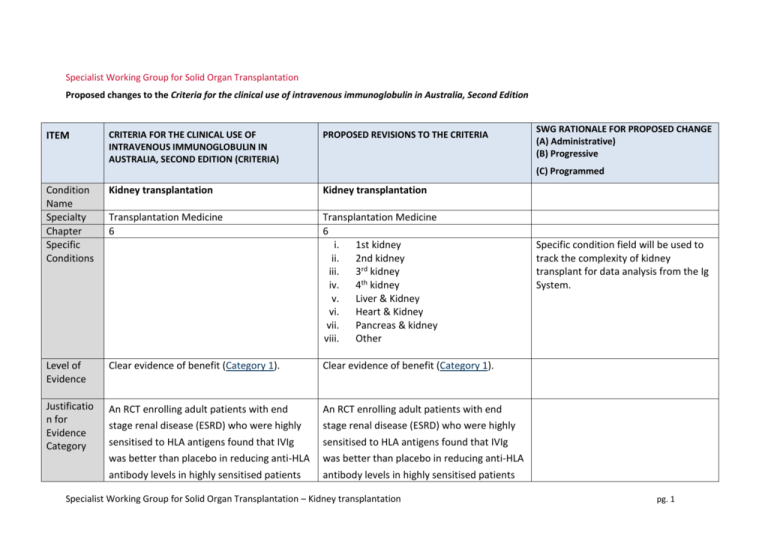
Specialist Working Group for Solid Organ Transplantation Proposed changes to the Criteria for the clinical use of intravenous immunoglobulin in Australia, Second Edition ITEM CRITERIA FOR THE CLINICAL USE OF INTRAVENOUS IMMUNOGLOBULIN IN AUSTRALIA, SECOND EDITION (CRITERIA) PROPOSED REVISIONS TO THE CRITERIA SWG RATIONALE FOR PROPOSED CHANGE (A) Administrative) (B) Progressive (C) Programmed Condition Name Specialty Chapter Specific Conditions Kidney transplantation Kidney transplantation Transplantation Medicine 6 Transplantation Medicine 6 i. 1st kidney ii. 2nd kidney iii. 3rd kidney iv. 4th kidney v. Liver & Kidney vi. Heart & Kidney vii. Pancreas & kidney viii. Other Level of Evidence Clear evidence of benefit (Category 1). Clear evidence of benefit (Category 1). Justificatio n for Evidence Category An RCT enrolling adult patients with end An RCT enrolling adult patients with end stage renal disease (ESRD) who were highly sensitised to HLA antigens found that IVIg was better than placebo in reducing anti-HLA antibody levels in highly sensitised patients stage renal disease (ESRD) who were highly sensitised to HLA antigens found that IVIg was better than placebo in reducing anti-HLA antibody levels in highly sensitised patients Specialist Working Group for Solid Organ Transplantation – Kidney transplantation Specific condition field will be used to track the complexity of kidney transplant for data analysis from the Ig System. pg. 1 with ESRD (followed for two years after transplant), and that transplant rates were improved with IVIg therapy (Jordan et al 2004). with ESRD (followed for two years after transplant), and that transplant rates were improved with IVIg therapy (Jordan et al 2004). Multiple case series have been reported in the literature, indicating efficacy in (acute) Multiple case series have been reported in the literature, indicating efficacy in (acute) antibody mediated rejection, and recommended by a consensus conference (Takemoto et al 2004). antibody mediated rejection, and recommended by a consensus conference (Takemoto et al 2004). Jordan et al (1998) combined data from seven renal transplant recipients and three heart transplant recipients with steroid- Jordan et al (1998) combined data from seven renal transplant recipients and three heart transplant recipients with steroid- resistant combined antibody-mediated and resistant combined antibody-mediated and cellular rejection. All patients in this series cellular rejection. All patients in this series were successfully treated with high-dose IVIg. were successfully treated with high-dose IVIg. A small RCT of transplanted patients with a five-year follow-up period showed that IVIg was as effective as OKT3 monoclonal A small RCT of transplanted patients with a five-year follow-up period showed that IVIg was as effective as OKT3 monoclonal antibodies in the treatment of steroid resistant rejection (survival rate at two years was 80% in both groups) but IVIg generated fewer side effects (Casadei et al 2001). antibodies in the treatment of steroid resistant rejection (survival rate at two years was 80% in both groups) but IVIg generated fewer side effects (Casadei et al 2001). Specialist Working Group for Solid Organ Transplantation – Kidney transplantation pg. 2 Description and Diagnostic Criteria There should be no change the published text Transplant rejection occurs when a recipient’s immune system attacks a transplanted organ or tissue. Despite the use of immunosuppressants, one or more episodes of rejection can occur after transplantation. Both cellular and humoral Transplant rejection occurs when a recipient’s immune system attacks a transplanted organ or tissue. Despite the use of immunosuppressants, one or more episodes of rejection can occur after transplantation. Both cellular and humoral (antibody-mediated) effector mechanisms can play a role. (antibody-mediated) effector mechanisms can play a role. The presence and pattern of rejection need to be established by biopsy. Laboratory tests to assess the presence and strength of antibodies to the donor antigens can provide additional useful information. Clinical The presence and pattern of rejection need to be established by biopsy. Laboratory tests to assess the presence and strength of antibodies to the donor antigens can provide additional useful information. Clinical assessment, blood tests, ultrasound and nuclear imaging are used primarily to exclude other causes of organ dysfunction. assessment, blood tests, ultrasound and nuclear imaging are used primarily to exclude other causes of organ dysfunction. Reference added to include BANFF criteria - the international standard for diagnostic features of antibody mediated rejection (AbMR). (A) Acute cellular rejection occurs in 15–30% of Acute cellular rejection occurs in 15–30% of renal transplants and is responsive to steroids renal transplants and is responsive to in more than 90% of cases. When rejection is steroids in more than 90% of cases. When steroid resistant, IVIg is a safer therapy than anti-T cell antibody therapy with equal efficacy. rejection is steroid resistant, IVIg is a safer therapy than anti-T cell antibody therapy with equal efficacy. Antibody mediated rejection (AbMR) occurs Antibody mediated rejection (AbMR) occurs Specialist Working Group for Solid Organ Transplantation – Kidney transplantation pg. 3 in 5–10% of renal transplants that have been performed with a compatible cross match. Before the use of IVIg and plasma exchange, AbMR failed to respond adequately to therapy in most cases. Additionally, complications from therapy were severe and in 5–10% of renal transplants that have been performed with a compatible cross match. Before the use of IVIg and plasma exchange, AbMR failed to respond adequately to therapy in most cases. Additionally, complications from therapy were severe and sometimes fatal. AbMR responds to IVIg with or without plasma exchange in more than 85% of patients. sometimes fatal. AbMR responds to IVIg with or without plasma exchange in more than 85% of patients. Diagnostic criteria for AbMR must be consistent with Banff Criteria (Banff 2013 Meeting Report American Journal of Transplantation 2014 :14;272-283 page 277). Diagnosis is required Diagnosis must be verified Exclusion Criteria No No Indications Pre-transplantation No Patients in whom an antibody or antibodies prevent transplantation (donor specific antihuman leukocyte antigen (HLA) antibody/ies By which speciality By which speciality N/A N/A Pre - transplant where donor specific antibody/ies prevent transplantation (HLA or anti-blood group) Post-transplant - acute anti-body mediated Specialist Working Group for Solid Organ Transplantation – Kidney transplantation Indications have been changed with the second indication removing eligibility for steroid resistant acute cellular rejection. Ig is rarely used for this requirement and if patients were very pg. 4 or anti-blood group antibody). rejection Post-transplantation Treatment or prevention of graft rejection where conventional immunosuppressive therapies is contraindicated or pose a threat to the graft or patient To treat steroid-resistant acute rejection which may be cellular or antibody mediated. ill, could be managed under the third indication. For prevention and/or treatment of rejection where other therapies are contraindicated or pose a threat to the graft or patient. Qualifying Criteria Pre-transplantation Patients in whom an antibody or antibodies prevent transplantation (donor-specific antiHLA antibody/ies or anti-blood group antibody). Post-transplantation Pre - transplant where donor specific antibody/ies prevent transplantation (HLA or anti-blood group) ABO incompatible transplant planned and/or HLA antibody / antibodies (minimum of 500 MFI) prevent organ transplantation 1. Biopsy proven cellular rejection unresponsive to steroids with clinical evidence of graft dysfunction; Post-transplant - active acute anti-body mediated rejection Eligibility criteria are more clearly defined and will greatly improve availability of data for future analysis (A) The relevant strength of HLA donor specific antibody(ies) has been under significant discussion within the SWG. Given the lack of strong evidence to support a definitive level, the qualifying value has been set at 500MFI and will be reviewed after 6-12 months of data collection and analysis. OR 2. Acute antibody mediated rejection with clinical evidence of graft Presence of incompatible ABO blood group donor specific antibody/antibodies and/or donor specific HLA antibody / antibodies (at Specialist Working Group for Solid Organ Transplantation – Kidney transplantation The presence of ABO or HLA antibodies and biopsy evidence (where relevant) have been included. Data will become available pg. 5 dysfunction; OR least a minimum of 500 MFI) regarding triggers for Ig use. AND 3. As treatment or prophylaxis for rejection where conventional immunosuppressive therapy is contraindicated, for example: in a patient with life-threatening infection in whom conventional immunosuppression will place the patient at even greater risk; Current clinical and laboratory evidence of graft dysfunction where biopsy is not available OR Organ biopsy demonstrates antibody mediated rejection according to Banff criteria1 OR when the transplant is at risk (e.g. due There is a high clinical suspicion that it is to BK virus infection). antibody mediated rejection and evidence is not yet available (one-off request in early period of acute rejection). For 2nd dose, DSA must be proven and biopsy must be abnormal but may not yet meet all of the Banff 1 diagnostic criteria. For subsequent doses, Banff1 criteria on biopsy must be met. 1. Banff 2013 Meeting Report American Journal of Transplantation 2014 :14;272-283 page 277. Specialist Working Group for Solid Organ Transplantation – Kidney transplantation Eligibility criteria have been revised to clearly differentiate between different patient groups that exist within indications (A) Donor specific antibodies may be known prior to transplant or may develop post transplant. Criteria must accommodate both physiological pathways for disease. Where a DSA is newly developing, HLA results may not be available immediately. In some instances, biopsy results may be unavailable or nondiagnostic in the early stages where treatment is required. Acceptable contra-indication reasons pg. 6 include: Treatment or prevention of graft rejection where conventional immunosuppressive therapies is contraindicated or pose a threat to the graft or patient Review Criteria Allograft organ function tests. Biopsy response. Laboratory monitoring of anti-HLA Dose Duration of graft and patient survival. Reversal of clinical graft dysfunction. IVIg with plasma exchange: 0.1 to 0.5 g/kg post exchange. IVIg alone: 2 g/kg to a maximum of 140 g as a single dose, or 2 to 3.5 g/kg in a divided dose. When IVIg is used alone, further doses may iii. iv. v. Significant infection or sepsis Potential for life threatening infection Life threatening condition Malignancy Marrow suppression and cytopenia Conventional immunosuppressive therapy is contraindicated and reason is provided. Detail of the reason to be provided. No review is required for one-off dosing Given that treatment is mostly by multiple single doses, very limited outcome data is likely to be collected within the system. Significant data is already available on transplant outcomes in other national systems the potential to interface the Ig System such databases will be considered in future. IVIg with plasma exchange 0.1 to 0.5 g/kg after each exchange (Total maximum dose of 2.5g/Kg divided across 5 doses) Dosing specifications have been more explicitly defined (within current policy allowances) to support current clinical practices and accommodate the variable approaches to treatment protocols in use nationally. (A) Data will be available for analysis in future that will support the identification of better antibody and/or anti-blood group antibody responses. i. ii. IVIg without plasma exchange (single dose) Up to 2 g/kg to a maximum of 140 g as a single dose. Specialist Working Group for Solid Organ Transplantation – Kidney transplantation pg. 7 be warranted two to four weeks after initial therapy depending on clinical response and/or biopsy findings. Dosing above 1 g/kg per day is contraindicated for some IVIg products. Refer to the current product information sheet for further information. The aim should be to use the lowest dose possible that achieves the appropriate clinical outcome for each patient. IVIg without plasma exchange (divided dose) 2 to 3.5g/kg in a divided dose practice. The aim should be to use the lowest dose possible that achieves the appropriate clinical outcome for each patient. Dosing above 1 g/kg per day is contraindicated for some IVIg products. Refer to the current product information sheet for further information. POTENTIAL OPERATIONAL IMPACT No operational impact is anticipated. POTENTIAL IMPACT ON DEMAND Patient Numbers Patients treated: & Usage 342 post tx (2%) 91 pre-tx (<1%) 2013-14 Usage : 1% No impact on demand is expected from these changes. There is unlikely to be significant change in variable practice until data becomes available for analysis to compare differences in usage and identify contributing reasons. POTENTIAL IMPACT ON COST Current cost Anticipated reduction in cost, if any Specialist Working Group for Solid Organ Transplantation – Kidney transplantation Marginal pg. 8 Marginal = borderline or unchanged from current cost Minor = decrease by $500K - $1.99M from current cost Major = decrease $2M+ from current cost BIBLIOGRAPHY Ahsan, N & Shah, KV 2002, ‘Polyomaviruses: an overview’, Graft, vol. 5, pp. S9–18. Banff 2013 Meeting Report, 2014, American Journal of Transplantation, vol 14, pp272-283 Biotext 2004, ‘Summary data on conditions and papers’, in A systematic literature review and report on the efficacy of intravenous immunoglobulin therapy and its risks, commissioned by the National Blood Authority on behalf of all Australian Governments, pp. 86–7. Available from: http://www.nba.gov.au/pubs/pdf/report-lit-rev.pdf. Casadei, DH, del C Rial, M, Opelz, G, et al 2001, ‘A randomised and prospective study comparing treatment with high-dose intravenous immunoglobulin with monoclonal antibodies for rescue of kidney grafts with steroid-resistant rejection’, Transplantation, vol. 71, no. 1, pp. 53–8. Conti, DJ, Freed, BM, Gruber, SA, et al 1994, ‘Prophylaxis of primary cytomegalovirus disease in renal transplant recipients. A trial of gancyclovir vs. immunoglobulin’, Archives of Surgery, vol. 129, no. 4, pp. 443–7. Frommer, M & Madronio, C 2006, The use of intravenous immunoglobulin in Australia. A report for the National Blood Authority, Part B: systematic literature review, Sydney Health Projects Group, University of Sydney, Sydney, pp. 18–20. Jordan, SC, Tyan, D, Stablein, D, et al 2004, ‘Evaluation of intravenous immunoglobulin as an agent to lower allosensitisation and improve transplantation in highly sensitized adult patients with end-stage renal disease: report of the NIH IG02 trial’, Journal of the American Society of Nephrology, vol. 15, no. 12, pp. 3256–62. Jordan, SC, Vo, A, Bunnapradist, S, et al 2003, ‘Intravenous immune globulin treatment inhibits cross match positivity and allows for successful transplantation of incompatible organs in living-donor and cadaver recipients’, Transplantation, vol. 76, no. 4, pp. 631–6. Jordan, SC, Vo, AA, Tyan, D, et al 2005, ‘Current approaches to treatment of antibody-mediated rejection’, Pediatric Transplantation, vol. 9, no. 3, pp. 408–15. Lian, M, Chan, W, Slavin, M, et al 2006, ‘Miliary tuberculosis in a Caucasian male transplant recipient and the role of intravenous immunoglobulin as Specialist Working Group for Solid Organ Transplantation – Kidney transplantation pg. 9 an immunosuppressive sparing agent’, Nephrology (Carlton), vol. 11, no. 2, pp. 156–8. Luke, PP, Scantlebury, VP, Jordan, ML, et al 2001, ‘Reversal of steroid- and anti-lymphocyte antibody-resistant rejection using intravenous immunoglobulin (IVIg) in renal transplant recipients’, Transplantation, vol. 72, no. 3, pp. 419–22. Moger, V, Ravishankar, M, Sakhuja, V, et al 2004, ‘Intravenous immunoglobulin: a safe option for treatment of steroid-resistant rejection in the presence of infection’, Transplantation, vol. 77, no. 9, pp. 1455–6. Orange, JS, Hossny, EM, Weiler, CR, et al 2006, ‘Use of intravenous immunoglobulin in human disease: A review of primary evidence by members of the Primary Immunodeficiency Committee of the American Academy of Allergy, Asthma and Immunology’, Journal of Allergy and Clinical Immunology, vol. 117, no. 4, pp. S525–53. Peraldi, MN, Akposso, K, Haymann, JP, et al 1996, ‘Long-term benefit of intravenous immunoglobulins in cadaveric kidney retransplantation’, Transplantation, vol. 62, no. 11, pp. 1670–3. Puliyanda, D, Radha, RK, Amet, N, et al 2003, ‘IVIg contains antibodies reactive with polyoma BK virus and may represent a therapeutic option for BK nephropathy’, American Journal of Transplantation, vol. 3, suppl. 4, p. 393. Sonnenday, CJ, Warren, DS, Cooper, MC, et al 2004, ‘Plasmapheresis, CMV hyperimmune globulin, and anti-CD20 allow ABO-incompatible renal transplantation without splenectomy’, American Journal of Transplantation, vol. 4, pp. 1315–22. Takemoto, SK, Zeevi, A, Feng, S, et al 2004, ‘National conference to assess antibody-mediated rejection in solid organ transplantation’, American Journal of Transplantation, vol. 4, no. 7, pp. 1033–41. Tydén, G, Kumlien, G, Genberg, H, et al 2005, ‘ABO incompatible kidney transplantations without splenectomy, using antigen-specific immunoadsorption and rituximab’, American Journal of Transplantation, vol. 5, no. 1, pp. 145–8. UK National Kidney Federation 2002, ‘Transplant’. Available from: www.kidney.org.uk/Medical-Info/transplant.html#rej [cited 7 Dec 2007]. END OF DOCUMENT Specialist Working Group for Solid Organ Transplantation – Kidney transplantation pg. 10


